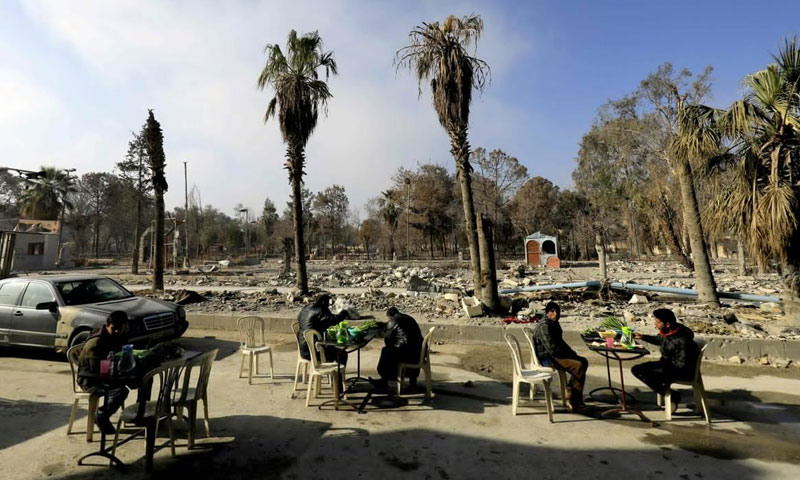



“We would not find any place like our homes and city to feel settled, but not as it is today,” says Um Mohammad (64 years old), who arrived at Raqqa after years of displacement, pointing out that “she definitely prefers to live in a tent on [her] home’s rubble away from the displacement’s humiliation.”
Um Mohammad’s family is one out of hundreds that started a gradual return to the city despite the deteriorating living conditions. Raqqa’s streets are today witnessing a simple revival since the “Syrian Democratic Forces” (SDF) have control it, in October 2017, after it suffered under the rule of the “Islamic State” (ISIS) for more than four years.
Abu Ali (39 years old) describes Raqqa as “a city of rubbles and debris scattered here and there,” when he returned to after leaving it at the end of 2016.
The man told Enab Baladi that dozens of families returned to Raqqa and a few shops opened their doors anew, optimistic about the upcoming days without hiding his worry and fear of ISIS’ remnants, despite the availability of needed commodities and basic needs for “reasonable” prices.
The “Raqqa Civil Council,” established by SDF in March 2017, continues to clean the city of rubbles and the war remnants. Omar (33 years old) is a volunteer at the City Council, said that the latter “is working with full power, despite all the lacking tools and resources, in cooperation with a number of international organizations.”
According to volunteers, the Al-Senaa, the areas behind the city’s wall and Rumaila are the neighborhoods that contain the largest number of mines.
The young man did not deny the city’s “disastrous” situation, assuring Enab Baladi that “the engineering teams are supervising dismantling the mines and clearing the streets and neighborhoods,” and explained that “in the past a few days, there were meetings with tow organizations, affiliates to the United States Department of State, within the same context, in addition to seven teams from the US.”
According to the Reconstruction Committee in Raqqa, in February, many buildings have been secured and cleared, including: The Maternity Hospital, the two schools of Tariq ibn Ziyad and Uqba ibn Nafi. Ali explained that the operations are focusing on the vital points in the city, such as bridges and major positions, while the “Internal Security Councils” took the responsibility of clearing the archeological museum and dozens of houses in its surrounding.
“We are still in need for additional modern machinery,” according to the volunteer who described the degree of destruction as “colossal” which demands “a lot of money and great efforts,” expecting that it is going to be “a long time” before Raqqa would start to resemble its old self.
According to the “Civil Council,” the people, to the day, have returned to the al-Mashlab and al-Tayar neighborhoods only after they have been totally cleared off landmines. Sources told Enab Baladi, that the council is seeking to reactivate the health, educational and service facilities, and to restore the water networks and reform infrastructure in these two neighborhoods.
Volunteers with the mines dismantling teams said that “the process is taking a slow rhythm considering the massive number of remnants and the sensitivity of many of them.”
Some people in Raqqa said that a number of families have violated the prohibition on entry to the mined neighborhoods, which led to deaths among civilians, demanding cooperation with the engineering teams and non-entry to insecure areas.
Activist from Raqqa said that a few members of the “Civil Council” are black mailing people, asking for payments, ranging from 75 to 400 thousand Syrian pounds, according to the location and its area, in return for clearing it of mines, especially in the two streets of 23 Shubtt and al-Mansour. However, the Council described this “as media overdramatization that leads to clamor,” pointing out “that some of [the members] received gratuities during the work and refused to take them.”
UN’s statistics report that the land mines in Raqqa are killing 50 to 70 people per week, which warn of a real danger if people, whose number is 450 thousand, kept returning.
In a press conference, on Wednesday, February 7, the Regional Humanitarian Coordinator for the Syria crisis Panos Moumtzis said that statistics indicate that “the number of unexploded ordnance in Raqqa is something that we have never seen before. Extreme. Every house, every room, every inch of the city.”
Despite the fact that “Médecins Sans Frontières” and the “World Health Organization” have allocated many medical points in the towns of Raqqa, al-Tabqah and Ayn Issa, in addition to individualistic and team volunteering efforts. Nevertheless, according to Enab Baladi’s reporter in the eastern area, these points do not accommodate the great number of injured people, pointing out that a single center is functioning in Ayn Issa, under “Médecins Sans Frontières,” backed by poor services, according to what patients have told the reporter.
if you think the article contain wrong information or you have additional details Send Correction